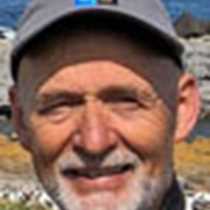Tysfjorden and Hellemobotn, mainland Norway
Yesterday evening the weather forecast for Tysfjorden seemed promising, and a great number of guests had signed up for kayaking after breakfast. However, the early risers onboard National Geographic Explorer were met by a rather naughty breeze as our vessel nosed into her anchorage at Hellemobotn. Hence, the kayaking had to be cancelled. Some of the kayakers instead chose to join a Zodiac cruise, whereas others decided to go hiking. Hellemobotn is the place in Norway where you find the shortest distance from the coast to Swedish territory. The long hikers followed a marked trail almost all the way to the Swedish border and attained an elevation of approximately 2,000 feet. The medium hikers walked through a beautiful forest of Scots pine and got up to a splashing waterfall. Late August is the peak season for wild berries, and several types were seen and sampled along the trail: wild raspberries, blueberries, crowberries, lingonberries and cloudberries. The photo groups found inspiration in the lush, green meadows and a beautiful stream and waterfall along the trail.
Hellemobotn was once a Sami village and was inhabited by Sami families until 1967. The Samis, once called the Lapps, were the original Stone Age inhabitants of these far northern lands. This Sami settlement was founded by two families who came from a group of reindeer herders further to the east. At this site at the edge of a rich coastal fjord they combined salmon fishing, hunting and small scale farming. The last person living permanently in the village moved out a decade ago. Today the houses and cabins in Hellemobotn are used for leisure purposes only.
During the afternoon we made a landing to visit the Leiknes petroglyphs. These artistic images of various animals are proof of the first humans to move in as the huge icecap from the last ice age retreated north some 9,000 years ago. Moose, reindeer, a full-sized killer whale and two swans are portrayed life size. The outlines of the petroglyphs have been ground and polished into the rock, making them stand out from the darker surface of the smooth granite slope.
The recap just before dinner naturally started with a short presentation on Sami rights, origin and culture. Boats, boots and skis were all important elements of Sami culture a long time before the more recent Nordic people moved in from the south. These are all key elements of the Norwegian culture.
After dinner many guests went out on deck to gaze up at the dramatic, dark scenery of Trollfjorden. This fjord has a very narrow mouth. Prior to our entrance into Trollfjorden our archeologist Carol Knott told a fascinating local myth about how this fjord had been created. She added, though, that the geologists might have a slightly different story to tell...
We left the fjord just after sunset, and golden peaks above this true home to trolls could be seen as we ended our first full day of exploration in the fjords of Norway.




